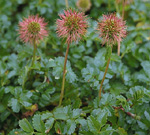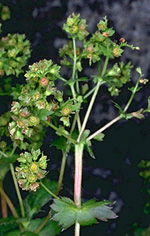 |
This is a large, almost cosmopolitan family best represented in temperate
parts of the Northern Hemisphere. In Australia it is also primarily temperate,
with most of the native members and many introduced ones found in forests,
grasslands and alpine herbfields of the south-eastern mainland and Tasmania,
fewer in south-west Western Australia, and with only a few species of
the large genus Rubus extending into tropical Queensland. No species
occur in the arid zone.
Characteristic features of the family Rosaceae in Australia include: - small trees, shrubs or herbs or (Rubus) prickly scramblers
- leaves alternate, simple or pinnately or palmately compound, often with glands at the junction of the petiole and blade, often with prominent stipules fused longitudinally to the petiole
- flowers usually white, with 5 free sepals and petals, the latter often rounded or the petals absent.
- stamens often numerous
- ovary inferior or superior, often enclosed within a hypanthium tube, usually with free carpels
- fruits very diverse, including fleshy and dry fruits, mostly indehiscent but some dehiscent
Description
Evergreen, deciduous or semi-deciduous trees, or shrubs, or woody
or herbaceous vines climbing by hooks, or annual or perennial terrestrial
herbs. Perennating by rhizomes, taproots or crowns. Vegetative reproduction
by rhizomes, stolons or root suckers. Stems unarmed or with prickles or
spines arising from the stem surface, or with thorns or spines arising
from the leaf axils; internodes terete, or distinctly angular. Extra-floral
nectaries absent, or on the foliage. Internal secretions not obvious.
Plants glabrous, or with simple, glandular or non-glandular, unicellular,
uniseriate or multiseriate hairs. Leaves alternate and spiral, cauline
or both basal and cauline if herbs, petiolate. Stipules present or absent,
distinct, free from or fused along petiole, scale-like or membranous,
green and leafy, bristle-like, lacerate or fimbriate, falling off early
or persistent; stipellae absent. Lamina simple or once compound, ternate,
palmate, imparipinnate, symmetric, pinnatifid, pinnatisect, palmatifid,
palmatisect; lamina/leaflets lanceolate, ovate, elliptic, oblanceolate,
oblong, flabellate or reniform; base cuneate, rounded or rarely cordate;
margins crenate, dentate or serrate, ±flat; one-veined, or the
venation pinnate, with the midrib conspicuous; tertiary venation reticulate
or inconspicuous; surfaces not punctate; herbaceous or leathery; distinctive
odour absent or aromatic. All the flowers bisexual. Inflorescences terminal
or axillary, consisting of panicles, corymbs or solitary flowers, or rarely
of heads or spikes. Bracts present or rarely apparently absent. Pollination
by insects or wind. Flowers odourless, fragrant or malodorous, stalked
or rarely sessile. Floral disc present; nectaries present on the free
to ±fused hypanthium. Free hypanthium absent or present. Perianth
regular, of 2 dissimilar whorls, imbricate in bud. Epicalyx present or
absent. Calyx segments free, with 5 sepals, herbaceous. Corolla segments
free, with 5 petals, alternating with the sepals, white, yellow, red or
pink, without contrasting markings, membranous; claws present or absent;
lobes ±entire. Fertile stamens 1, 2, 5, or 10–numerous, not clearly
correlated with the sepals, free or at least partly fused to the corolla,
free of the ovary and style, distinct from each other, all ±equal.
Staminodes present or absent. Anthers dorsifixed or basifixed, versatile,
opening outwards or inwards by longitudinal slits, 2-celled. Ovary superior
and sessile, part-inferior or inferior. Carpels 1–100, free, fused, or
free but styles or stigmas fused, fully closed or incompletely closed;
ovary with 1–5 locules. Style gynobasic or terminal, single and unbranched,
or branched above or from the base. Ovules 1–2 per locule, sessile; placentation
basal. Fruit dry or fleshy, indehiscent or rarely dehiscent; an achene
(usually several clustered inside a 'hip'), or a drupe, or a pome, rarely
a follicle; the perianth on the maturing fruit deciduous, or dry and persistent.
Disseminule macro-surface featureless, or with straight hairs, awns or
barbed spines; micro-surface ±smooth, aculeate or rugose, green,
yellow, orange, red or black, glossy or dull. Seeds 1–10 per fruit.
Aril absent. Cotyledons 2. Embryo straight.
(Note: this description has been generated from the coded data compiled for the key. Any errors in the key data will be reflected in the descriptions.)
A treatment of the family Rosaceae has not yet been published in the Flora of Australia. It will appear in Volume 10.
Australian genera of Rosaceae (as recognised for the Flora of Australia)
† = some species native, others introduced
* = all species introduced
Acaena
*Agrimonia
*Alchemilla
†Aphanes
*Aruncus
*Chaenomeles
*Cotoneaster
*Crataegus
*Cydonia
*Duchesnea
*Eriobotrya
*Fragaria
Geum
*Malus
*Potentilla
*Poterium
*Prunus
*Pyracantha
*Pyrus
Rhaphiolepis
*Rosa
†Rubus
*Sanguisorba
*Sorbus
*Spiraea

|
  |

Acaena montana (flowers)
Photo: M.Fagg © M.Fagg

Acaena novae-zelandiae (fruits)
Photo: M.Fagg © ANBG

Alchemilla xanthochlora (flowers)
Photo: R.Jackson © ANBG

Alchemilla xanthochlora (habit)
Photo: C.Totterdell © ANBG

|
 |
|